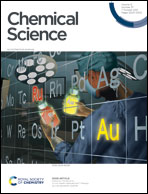The power of trichlorosilylation: isolable trisilylated allyl anions, allyl radicals, and allenyl anions†
Abstract
Treatment of hexachloropropene (Cl2C![[double bond, length as m-dash]](https://www.rsc.org/images/entities/char_e001.gif) C(Cl)–CCl3) with Si2Cl6 and [nBu4N]Cl (1 : 4 : 1) in CH2Cl2 results in a quantitative conversion to the trisilylated, dichlorinated allyl anion salt [nBu4N][Cl2C
C(Cl)–CCl3) with Si2Cl6 and [nBu4N]Cl (1 : 4 : 1) in CH2Cl2 results in a quantitative conversion to the trisilylated, dichlorinated allyl anion salt [nBu4N][Cl2C![[double bond, length as m-dash]](https://www.rsc.org/images/entities/char_e001.gif) C(SiCl3)–C(SiCl3)2] ([nBu4N][1]). Tetrachloroallene Cl2C
C(SiCl3)–C(SiCl3)2] ([nBu4N][1]). Tetrachloroallene Cl2C![[double bond, length as m-dash]](https://www.rsc.org/images/entities/char_e001.gif) C
C![[double bond, length as m-dash]](https://www.rsc.org/images/entities/char_e001.gif) CCl2 was identified as the first intermediate of the reaction cascade. In the solid state, [1]− adopts approximate Cs symmetry with a dihedral angle between the planes running through the olefinic and carbanionic fragments of [1]− of C
CCl2 was identified as the first intermediate of the reaction cascade. In the solid state, [1]− adopts approximate Cs symmetry with a dihedral angle between the planes running through the olefinic and carbanionic fragments of [1]− of C![[double bond, length as m-dash]](https://www.rsc.org/images/entities/char_e001.gif) C–Si//Si–C–Si = 78.3(1)°. One-electron oxidation of [nBu4N][1] with SbCl5 furnishes the distillable blue radical 1˙. The neutral propene Cl2C
C–Si//Si–C–Si = 78.3(1)°. One-electron oxidation of [nBu4N][1] with SbCl5 furnishes the distillable blue radical 1˙. The neutral propene Cl2C![[double bond, length as m-dash]](https://www.rsc.org/images/entities/char_e001.gif) C(SiCl3)–C(SiCl3)2H (2) was obtained by (i) protonation of [1]− with HOSO2CF3 (HOTf) or (ii) H-atom transfer to 1˙ from 1,4-cyclohexadiene. Quantitative transformation of all three SiCl3 substituents in 2 to Si(OMe)3 (2OMe) or SiMe3 (2Me) substituents was achieved by using MeOH/NMe2Et or MeMgBr in CH2Cl2 or THF, respectively. Upon addition of 2 equiv. of tBuLi, 2Me underwent deprotonation with subsequent LiCl elimination, 1,2-SiMe3 migration and Cl/Li exchange to afford the allenyl lithium compound Me3Si(Li)C
C(SiCl3)–C(SiCl3)2H (2) was obtained by (i) protonation of [1]− with HOSO2CF3 (HOTf) or (ii) H-atom transfer to 1˙ from 1,4-cyclohexadiene. Quantitative transformation of all three SiCl3 substituents in 2 to Si(OMe)3 (2OMe) or SiMe3 (2Me) substituents was achieved by using MeOH/NMe2Et or MeMgBr in CH2Cl2 or THF, respectively. Upon addition of 2 equiv. of tBuLi, 2Me underwent deprotonation with subsequent LiCl elimination, 1,2-SiMe3 migration and Cl/Li exchange to afford the allenyl lithium compound Me3Si(Li)C![[double bond, length as m-dash]](https://www.rsc.org/images/entities/char_e001.gif) C
C![[double bond, length as m-dash]](https://www.rsc.org/images/entities/char_e001.gif) C(SiMe3)2 (Li[4]), which is an efficient building block for the introduction of Me, SiMe3, or SnMe3 (5) groups. The trisilylated, monochlorinated allene Cl3Si(Cl)C
C(SiMe3)2 (Li[4]), which is an efficient building block for the introduction of Me, SiMe3, or SnMe3 (5) groups. The trisilylated, monochlorinated allene Cl3Si(Cl)C![[double bond, length as m-dash]](https://www.rsc.org/images/entities/char_e001.gif) C
C![[double bond, length as m-dash]](https://www.rsc.org/images/entities/char_e001.gif) C(SiCl3)2 (6), was obtained from [nBu4N][1] through Cl−-ion abstraction with AlCl3 and rearrangement in CH2Cl2 (1˙ forms as a minor side product, likely because the system AlCl3/CH2Cl2 can also act as a one-electron oxidant).
C(SiCl3)2 (6), was obtained from [nBu4N][1] through Cl−-ion abstraction with AlCl3 and rearrangement in CH2Cl2 (1˙ forms as a minor side product, likely because the system AlCl3/CH2Cl2 can also act as a one-electron oxidant).



 Please wait while we load your content...
Please wait while we load your content...